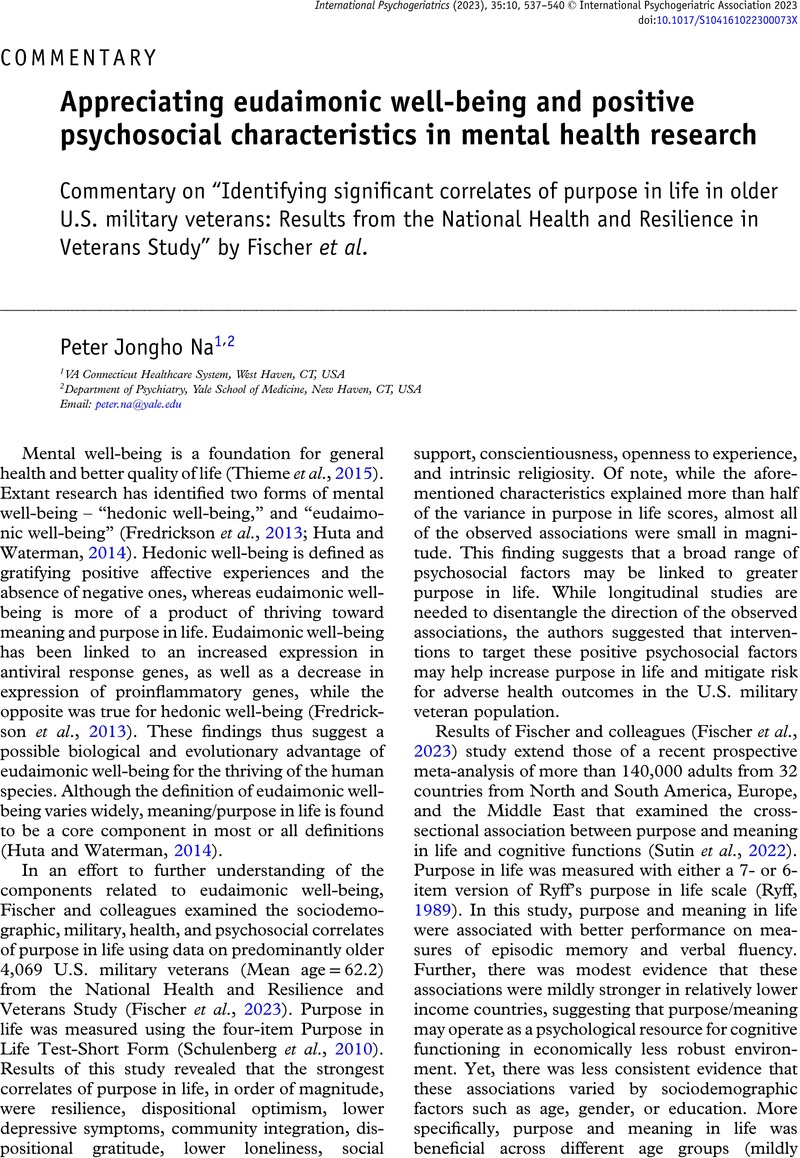No CrossRef data available.
Article contents
Appreciating eudaimonic well-being and positive psychosocial characteristics in mental health research
Commentary on “Identifying significant correlates of purpose in life in older U.S. military veterans: Results from the National Health and Resilience in Veterans Study” by Fischer et al.
Published online by Cambridge University Press: 24 August 2023
Abstract
An abstract is not available for this content so a preview has been provided. Please use the Get access link above for information on how to access this content.

- Type
- Commentary
- Information
- International Psychogeriatrics , Volume 35 , Special Issue 10: Issue Theme: Aging and Well-Being , October 2023 , pp. 537 - 540
- Copyright
- © International Psychogeriatric Association 2023
References
Chochinov, H. M., Hack, T., Hassard, T., Kristjanson, L. J., McClement, S. and Harlos, M. (2006). Dignity therapy: a novel psychotherapeutic intervention for patients near the end of life. Journal of Clinical Oncology, 23, 5520–5525.CrossRefGoogle Scholar
Davis, D. E. et al. (2016). Thankful for the little things: a meta-analysis of gratitude interventions. Journal of Counseling Psychology, 63, 20–31.CrossRefGoogle ScholarPubMed
Dewitte, L., Vandenbulcke, M. and Dezutter, J. (2019). Meaning in life matters for older adults with Alzheimer’s disease in residential care: associations with life satisfaction and depressive symptoms. International Psychogeriatrics, 31, 607–615.CrossRefGoogle ScholarPubMed
Fischer, I. C. et al. (2023). Identifying significant correlates of purpose in life in older US military veterans: results from the national health and resilience in veterans study. International Psychogeriatrics, 1-6, 1–6.CrossRefGoogle Scholar
Fredrickson, B. L. et al. (2013). A functional genomic perspective on human well-being. Proceedings of the National Academy of Sciences, 110, 13684–13689.CrossRefGoogle ScholarPubMed
Hayes, S. C., Luoma, J. B., Bond, F. K., Masuda, A. and Lillis, J. (2006). Acceptance and commitment therapy: model, processes and outcomes. Behaviour Research and Therapy, 44, 1–25.CrossRefGoogle ScholarPubMed
Huta, V. and Waterman, A. S. (2014). Eudaimonia and its distinction from Hedonia: developing a classification and terminology for understanding conceptual and operational definitions. Journal of Happiness Studies, 15, 1425–1456.CrossRefGoogle Scholar
Jeste, D. V., Palmer, B. W., Rettew, D. C. and Boardman, S. (2015). Positive psychiatry: its time has come. The Journal of Clinical Psychiatry, 76, 675–683.CrossRefGoogle ScholarPubMed
Malouff, J. M. and Schutte, N. S. (2016). Can psychological interventions increase optimism? A meta-analysis. The Journal of Positive Psychology, 12, 594–604.CrossRefGoogle Scholar
Marshall, M. and Marshall, E. (2012). Logotherapy Revisited: Review of the Tenets of Viktor E. Frankl’s logotherapy. Ottawa: Edward Marshall.Google Scholar
Mei, Z. et al. (2021). Important correlates of purpose in life identified through a machine learning approach. The American Journal of Geriatric Psychiatry, 29, 488–498.CrossRefGoogle ScholarPubMed
National Academies of Sciences, Engineering, and Medicine (2023). Achieving Whole Health: A New Approach for Veterans and the Nation. Washington, DC: The National Academies Press.Google Scholar
Ryff, C. D. (1989). Happiness is everything, or is it? Explorations on the meaning of psychological well-being. Journal of Personality and Social Psychology, 57, 1069–1081.CrossRefGoogle Scholar
Ryff, C. D. (2014). Psychological well-being revisited: advances in the science and practice of eudaimonia. Psychotherapy and Psychosomatics, 83, 10–28.CrossRefGoogle ScholarPubMed
Schulenberg, S. E., Schnetzer, L. W. and Buchanan, E. M. (2010). The purpose in life test-short form: development and psychometric support. Journal of Happiness Studies, 20, 1–16.Google Scholar
Steger, M. and Samman, E. (2012). Assessing meaning in life on an international scale: psychometric evidence for the Meaning in Life Questionnaire-Short Form among Chilean households. International Journal of Wellbeing, 2, 182–195.CrossRefGoogle Scholar
Sutin, A. R., Luchetti, M., Stephan, Y., Strickhouser, J. E. and Terracciano, A. (2022). The association between purpose/meaning in life and verbal fluency and episodic memory: a meta-analysis of >140,000 participants from up to 32 countries. International Psychogeriatrics, 34, 263–273.CrossRefGoogle ScholarPubMed
Taylor, P. (2021). Compassionate Contact Corps Provides Social Support for Veterans. VAntage Point. https://news.va.gov/88231/compassionate-contact-corps-provides-social-support-veterans/
Google Scholar
Thieme, A., Wallace, J., Meyer, T. D. and Oliver, P. (2015). Designing for mental wellbeing: Towards a more holistic approach in the treatment and prevention of mental illness. In: British HCI ’15: Proceeding of the 2015 British HCI Conference, pages 1–10.Google Scholar
U.S. Department of Veterans Affairs. (2021). Implementing a Whole Health System: Patient and Team Perspectives. Washington, DC: U.S. Department of Veterans Affairs.Google Scholar


